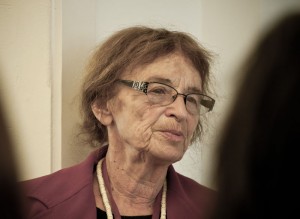
A week’s worth of immersion in Renaissance art requires both time for contemplation and occasion for discourse. As such, the spring term’s core course on Values of Florentine Renaissance commenced with a guest lecture by the prominent Hungarian philosopher Agnes Heller.
Professor Heller broached the topic of historical interpretation by briefly discussing Goethe and Hegel’s views about the Renaissance, particularly the view that the primary concern during the said period was beauty. Professor Heller carried the idea further by saying that the Renaissance’s preoccupation with beauty is one of many expressions of a greater development, which she called the dynamics of modernity.
These dynamics manifested themselves in the processes of questioning conventions, standards, and traditions, and of searching for answers, which eventually burgeoned into an all-encompassing social movement. In time, the individual stepped into the spotlight and developed into a creature of choices. The application of knowledge and improvements in technology only served to amplify these changes.
Professor Heller looked to Giotto and the discovery of perspective in painting as fitting examples of these changes. Perspective endowed works of art with a sense of stylized reality, wherein seeing in painting tries to emulate seeing in everyday reality. The technicalities of perspective are not as important to the discourse as the manner in which the technique affects an individual’s viewing experience. In Giotto’s works, the body was given meaning. Clothing functioned as an allusion to the nakedness of figures, giving flesh to characters in religious narratives. Divine images were no longer mere representations and also drew the audience into commune with their framed realities, opening up questions about truth and beauty among others.
Professor Heller emphasized individual choice, particularly one’s own choice of history. Autobiographies became fashionable; as much as people of Renaissance Florence saw the seemingly real in works of art, they may have been equally satisfied by artful treatments in their personal histories. Language also turned into a matter of choice, as the use of vernacular grew more popular and Latin was slowly marginalized.
Heller then turned her sights to politics, starting with Machiavelli’s political philosophy. In The Prince, Machiavelli manages to separate politics from morality, where the former is defined by its results or outcomes while the latter deals with intentions. What was previously viewed as a singular choice transformed into a pluralistic concept of the good. Conflict became useful, even productive.
To Professor Heller, the Renaissance was defined by its pluralism. One can choose to view the Renaissance as the merging of Ancient Greek and Roman traditions with Christianity, but it was not simply a revival of the past. In art, politics, and religion, the era was marked by its achievements in re-creation—in using what one chooses from history and developing from it something of one’s own.
Professor Heller defined historical interpretation as the mediation of the past and the present. From 19th century views of the Renaissance as an era focused on beauty and humanism, to the current political narrative of it as one marred by conflict and the so-called the first fundamentalist Savonarola, it seems that intellectual thought is indelibly marked by the dynamics of modernity.
by April Matias (1st year BA, Philippines)
